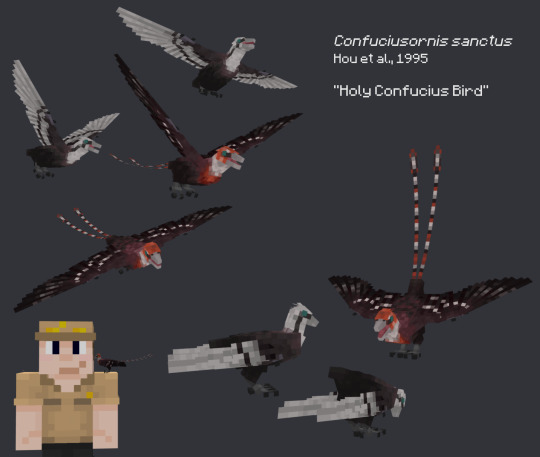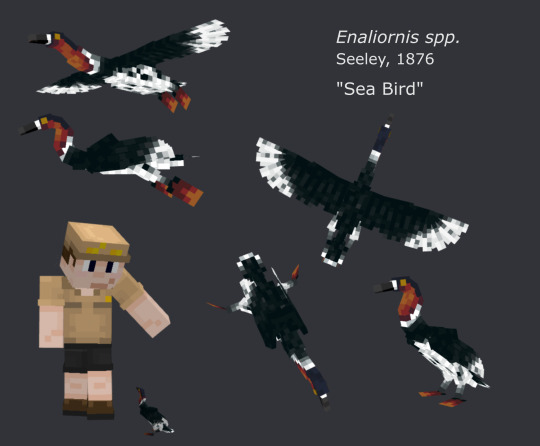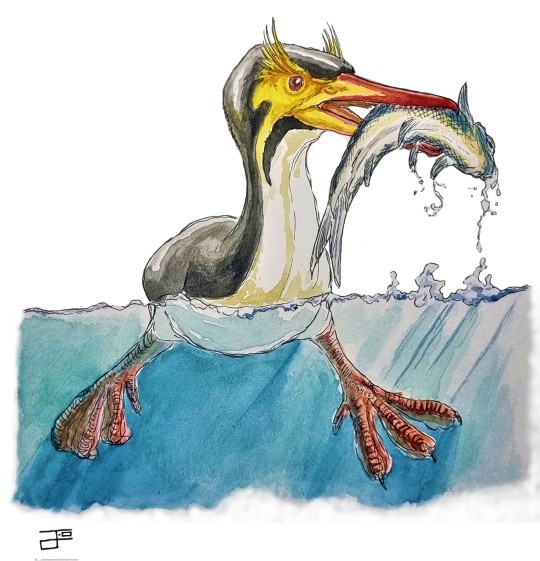#enaliornis
Explore tagged Tumblr posts
Text
A couple of birds I modeled and textured for the Prehistoric Nature mod


Confuciusornis
Known from Yixian and the overlying Jiufotang Formation of China, this animal has been found in great abundance, numbering hundreds of specimens. Like many modern birds, Confuciusornis was likely sexually dimorphic, with distinct male and female forms. However, the exact nature of this dimorphism has long been controversial, with the big question being whether the tail streamers, known from only a fraction of preserved specimens, were present in both sexes. Fortunately, a 2024 study based on nearly 200 specimens found a statistically significant correlation between the presence of tail feathers, total body mass, and limb proportions, supporting the conclusion that the tailed form most likely represents the male sex. Also like modern birds, Confuciusornis completely lacked teeth, though this appears to have been a convergent innovation, as teeth were still present in several lineages closer to the Neoaves.
Enaliornis
Enaliornis is a genus of primitive Hesperornithiformes that lived from the Albian to Cenomanian in what was then the Tethys Sea. Despite being known from numerous individuals and three separate species, it is incredibly fragmentary, and any reconstruction is largely an exercise in speculation. It is unknown whether it was flightless like more derived Hesperornithiformes, as the forelimbs are not preserved. Like its later cousins, Enaliornis was a specialized foot-propelled diver, though it was likely still capable of upright terrestrial locomotion.

Check out the rest of our recent work on the Prehistoric Nature discord server!

#minecraft#paleontology#prehistoric nature#modded minecraft#blockbench#palaeoblr#confuciusornis#enaliornis
462 notes
·
View notes
Text

artwork by @thewoodparable!
92 notes
·
View notes
Photo


Couple of palaeoart watercolours - the Cretaceous hesperornithine bird Enaliornis and a non-descript Mesozoic mammal at the feet of its reptilian overlords (for now)...
#paleoart#paleontology#dinosaur#bird#seabird#watercolour#painting#natural history#scientific illustration#mesozoic#cretaceous#reptile#earth history#prehistoric
20 notes
·
View notes
Note
Which hesperornithiforms were plausibly volant?
Enaliornis has been suggested to have been volant on account of its small size, though forelimb material to confirm this is unknown, and Galton and Martin (2002) argued that flightlessness was more likely given that it had highly thickened bone walls (like most other hesperornithiforms). Brodavis has conversely been considered possibly flight capable because it had relatively thin bone walls, but forelimb bones are not known for it either.
Some forelimb elements are known for Pasquiaornis, and seeing as they were less reduced than in later hesperornithiforms, it has been suggested that it may have still had some flight abilities. Joseph Sanchez’s unpublished Master’s thesis described additional forelimb material and concluded that Pasquiaornis might have been capable of flight, but likely only for short distances.
0 notes
Text
Enaliornis barretti, E. sedgwicki, E. seeleyi

By José Carlos Cortés on @quetzalcuetzpalin-art
PLEASE SUPPORT US ON PATREON. EACH and EVERY DONATION helps to keep this blog running! Any amount, even ONE DOLLAR is APPRECIATED! IF YOU ENJOY THIS CONTENT, please CONSIDER DONATING!
Name: Enaliornis barretti, E. sedgwicki, E. seeleyi
Name Meaning: Seabird
First Described: 1876
Described By: Seeley
Classification: Dinosauria, Theropoda, Neotheropoda, Averostra, Tetanurae, Orionides, Avetheropoda, Coelurosauria, Tyrannoraptora, Maniraptoriformes, Maniraptora, Pennaraptora, Paraves, Eumaniraptora, Averaptora, Avialae, Euavialae, Avebrevicauda, Pygostylia, Ornithothoraces, Euornithes, Ornithuromorpha, Ornithurae, Hesperornithes
Enaliornis is th eoldest known Hesperornithine, and it also is one that shows the transition from an Ichthyornis-esque ancestor to highlight specialized diving dinosaurs such as Hesperornis the best, as it was a small, swimming animal that also could dive, but were much more similar to “conventional” Euronithes. It was similar to loons and ducks, in a way, with a much more squat body. It lived in the Cambridge Greensand Formation of England, about 100 million years ago, in the Albian age of the Early Cretaceous to the Cenomanian age of the Late Cretaceous. It had a small skull and long legs for paddling and coastal diving, and it may have been a dipper, an dit probably could still fly. It had a body length of about 55 centimeters.
Sources:
Martyniuk, M. P. 2012. A Field Guide to Mesozoic Birds and other Winged Dinosaurs. Pan Aves; Vernon, New Jersey.
https://en.wikipedia.org/wiki/Enaliornis
Shout out goes to @frsphoto!
#enaliornis#bird#dinosaur#hesperornithine#birblr#palaeoblr#enaliornis barretti#enaliornis sedgwicki#enaliornis seeleyi#paleontology#prehistory#prehistoric life#dinosaurs#biology#a dinosaur a day#a-dinosaur-a-day#dinosaur of the day#dinosaur-of-the-day#science#nature#factfile#Dìneasar#דינוזאור#डायनासोर#ديناصور#ডাইনোসর#risaeðla#ڈایناسور#deinosor#恐龍
46 notes
·
View notes